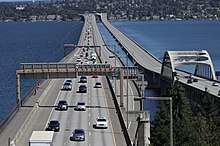Homer M. Hadley Memorial Bridge
The Third Lake Washington Bridge, officially the Homer M. Hadley Memorial Bridge, is one of the Interstate 90 floating bridges. It is the fifth-longest floating bridge in the world, at 5,811 feet (1772 m). It carries the westbound lanes of Interstate 90 across Lake Washington between Mercer Island, Washington, and Seattle, Washington.
Homer M. Hadley Memorial Bridge | |
|---|---|
 The two spans of the Homer M. Hadley Memorial Bridge (left) and the Lacey V. Murrow Memorial Bridge (right), looking east toward Mercer Island | |
| Coordinates | 47°35′23″N 122°16′08″W |
| Carries | |
| Crosses | Lake Washington, Washington |
| Locale | Seattle, Washington, United States |
| Maintained by | Washington State Department of Transportation |
| Characteristics | |
| Design | Pontoon bridge |
| Total length | 5,811 ft (1,771 m) |
| History | |
| Opened | June 4, 1989 |

| |
History
The bridge was built in 1989 and is named for Homer More Hadley, who designed the bridge's companion span, the Lacey V. Murrow Memorial Bridge. Hadley also designed the McMillin Bridge in Pierce County.[1]
When the bridge was built, parallel to the Lacey V. Murrow Memorial Bridge, two reversible high-occupancy vehicle (HOV) lanes were set up to accommodate the traffic flow between Seattle and the suburban Eastside (westbound in the morning, eastbound in the evenings).
Sound Transit and the Washington State Department of Transportation added HOV lanes to the bridge's westbound lanes in 2017.[2] This preceded construction of the East Link light rail line from downtown Seattle to Bellevue and Redmond, which will use the former reversible express lanes. East Link, scheduled to be completed in 2023, will be the first time that a light-rail line will operate on a floating bridge.[3][4]
Usage
The bridge carries four westbound lanes, including a HOV lane, as well as a bicycle and pedestrian path on the north side.
Prior to 2017, it also carried two reversible lanes, configured to normally carry westbound traffic on weekday mornings and eastbound traffic at other times. Use of the reversible express lanes was restricted to HOV traffic, except for vehicles traveling to and from Mercer Island.
With a total of five traffic lanes and three full-sized shoulders, the Third Lake Washington Bridge was the widest floating bridge in the world, until the completion of the new Evergreen Point Floating Bridge in 2016.[5]
See also
- Lacey V. Murrow Memorial Bridge
- List of Seattle bridges
References
- Todd Matthews (November 16, 2012), "Fearing its demolition, preservationists nominate McMillin Bridge to Pierce County's historic register", Tacoma Daily Index
- "New I-90 HOV lane from Mercer Island to Bellevue opens today" (Press release). Sound Transit. March 29, 2012. Retrieved February 21, 2018.
- Lindblom, Mike (May 14, 2017). "World's first light rail on a floating bridge: For I-90, Sound Transit had to invent 'a brilliant solution'". The Seattle Times. p. A1. Retrieved February 21, 2018.
- Lindblom, Mike (June 1, 2017). "Mercer Island braces for new I-90 bottlenecks as light-rail work begins". The Seattle Times. p. A1. Retrieved February 21, 2018.
- "Uniquely Northwest: Washington State is home to many of world's amazing floating bridges" (PDF). Hood Canal Bridge News. Washington State Department of Transportation. Summer 2003. p. 2. Archived from the original (PDF) on October 7, 2006. Retrieved July 24, 2015.